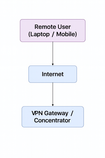EIGRP Routing Protocol: Design Principles for Enterprise Networks
- The Itvue Team
- Aug 20
- 2 min read
Author Ermias Teffera
At ITVue Networks, designing scalable and resilient networks is critical. EIGRP (Enhanced Interior Gateway Routing Protocol) is a Cisco-proprietary distance-vector routing protocol optimized for large enterprise networks. In this blog, we’ll explore EIGRP design principles, hierarchical topology considerations, route summarization, and real-world Cisco configurations.
What is EIGRP?
EIGRP is an advanced distance-vector routing protocol that combines the simplicity of distance-vector with the fast convergence of link-state features. Key characteristics:
Uses DUAL (Diffusing Update Algorithm) for loop-free, rapid convergence
Supports VLSM (Variable Length Subnet Mask)
Provides unequal-cost load balancing
Minimizes unnecessary routing updates
EIGRP Hierarchical Design
Like OSPF, EIGRP benefits from a hierarchical design to improve scalability:
Access Layer – Connects end devices to distribution routers
Distribution Layer – Aggregates access switches, handles policy, summarization, and redundancy
Core Layer – Backbone providing high-speed routing between distribution blocks
Recommended Ratios:
Access-to-Distribution: 20:1
Distribution-to-Core: 8:1
These ratios help prevent oversubscription and maintain predictable performance.
Key EIGRP Design Principles
1. Neighbor Relationships
Establish EIGRP neighbor relationships on all router interfaces within the same AS.
Use passive interfaces on links that should not form neighbors (e.g., client-facing interfaces).
2. Route Summarization
Summarize routes at distribution routers to reduce routing table size.
Example: 192.168.10.0/24 and 192.168.11.0/24 → 192.168.8.0/21
3. Bandwidth & Delay Metric Tuning
.
EIGRP selects the best path based on composite metric: bandwidth, delay, reliability, and load
Tweak interface bandwidth and delay to influence path selection
4. Unequal-Cost Load Balancing
By default, EIGRP performs equal-cost load balancing.
variance command allows traffic over multiple paths with different metrics:

This allows a backup link with a slightly higher metric to carry traffic.
EIGRP Network Diagram
+-------------------+
| Core Router |
+---------+---------+
|
8:1 Ratio
|
+---------+---------+
| Distribution |
+---------+---------+
| |
20:1 Ratio 20:1 Ratio
+-----+ +-----+
|Access| |Access|
+-----+ +-----+
EIGRP adjacency is formed on all distribution and core routers
Access routers advertise their networks into distribution
Cisco Configuration Example


no auto-summary ensures proper handling of discontiguous networks
passive-interface prevents EIGRP hellos on client-facing ports
Best Practices for EIGRP
Use hierarchical design to control update propagation
Summarize routes at distribution and edge to reduce table size
Monitor metrics using show ip eigrp topology and show ip route eigrp
Use EtherChannel or LACP for aggregated links to improve bandwidth
Combine variance for controlled unequal-cost load balancing
Real-World Example
In an enterprise campus:
Each floor has access switches connecting client devices
Access routers advertise VLAN networks into distribution EIGRP routers
Distribution routers summarize and connect to the core
Unequal-cost paths and EtherChannel links ensure high availability, load balancing, and minimal downtime
Conclusion
EIGRP is a powerful routing protocol when designed with hierarchical structure, route summarization, and careful metric tuning. At ITVue Networks, we implement EIGRP with proper access-distribution-core design, EtherChannel, and variance-based load balancing to ensure enterprise networks are resilient, efficient, and scalable.










Comments